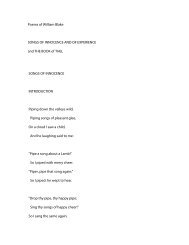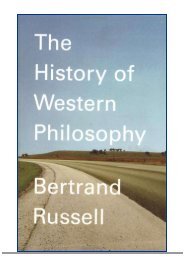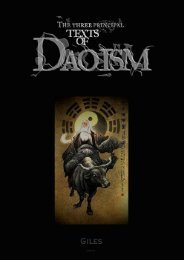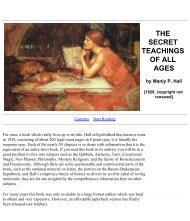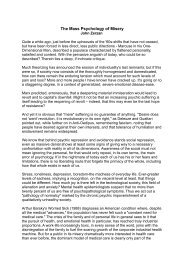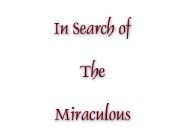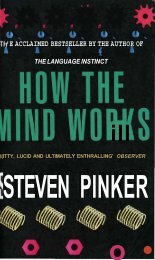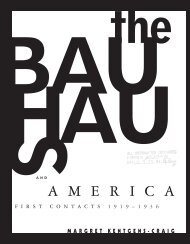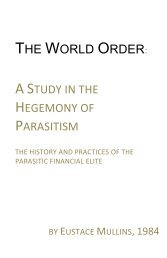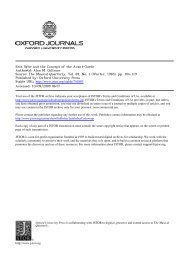not an avenue. Although man's horizons expanded, his world becameincreasingly narrow as his vision was sectorized by the blinders of theperspectival world view. <strong>The</strong> gradual movement toward clearer vision wasaccompanied by a proportionate narrowing of his visual sector. <strong>The</strong> deeperand farther we extend our view into space, the narrower is the sector ofour visual pyramid.As it developed over the centuries, this state of affairs gave rise to themost destructive of the stigmas of our age: the universal intolerance thatprevails today, and the fanaticism to which it leads. A person who isanxious, or who is fleeing from something, or who is lost either withrespect to his own ego or with respect to the world - it holds equally truein both instances - is a person who will always be intolerant, as he feelsthreatened in his vital interests. He "sees" only a vanishing point lost inthe misty distance (the vanishing point of linear perspective of whichLeonardo once wrote); and he feels obliged to defend his point fanatically,lest he lose his world entirely.<strong>The</strong> European of today, either as an individual or as a member of thecollective, can perceive only his own sector. This is true of all spheres, thereligious as well as the political, the social as well as the scientific. <strong>The</strong> riseof Protestantism fragmented religion; the ascendancy of national statesdivided the Christian Occident into separate individual states; the rise ofpolitical parties divided the people (or the former Christian community)into political interest groups. In the sciences, this process of segmentationled to the contemporary state of narrow specialization and the "greatachievements" of the man with tunnel vision. And there is no "going back";the ties to the past, the re-ligio, are almost non-existent, having beensevered, as it were, by the cutting edge of the visual pyramid. As for asimple onward progression and continuity (which has almost taken an thecharacter of a flight), they lead only to further sectors of particularizationand, ultimately, to atomization. After that, what remains, like what was leftin the crater of Hiroshima, is only an amorphous dust; and it is probablethat at least one part of humanity will follow this path, at least in "spirit,"i.e., psychologically.In summary, then, the following picture emerges: there is on the one handanxiety about time and one's powerlessness against it, and on the other, a"delight" resulting from the conquest of space and the attendantexpansion of power; there is also the isolation of the individual or group orcultural sphere as well as the collectivization of the same individuals ininterest groups. This tension between anxiety and delight, isolation andcollectivization is the ultimate result of an epoch which has outlived itself.Nevertheless, this epoch could serve as a guarantee that we reach a new"target," if we could utilize it much as the arrow uses an over-taut bowstring. Yet like the arrow, our epoch must detach itself from the extremesthat make possible the tension behind its flight toward the target. Like thearrow on the string, our epoch must find the point where the target isalready latently present: the equilibrium between anxiety and delight,isolation and collectivization. Only then can it liberate itself from deficient26
unperspectivity and perspectivity, and achieve what we shall call, alsobecause of its liberating character, theaperspectival world.3. <strong>The</strong> Aperspectival World<strong>The</strong> full outlines of the aperspectival world can emerge only gradually. It isour hope that it will take on shape and contour as we have occasion totreat its "past” prefigurations and contexts; an object becomes clearlyvisible and distinct, after all, only when placed against a background orsubstratum which furnishes sufficient contrast to prevent its beingmisconstrued. Although that requirement may not yet be fulfilled at thisstage of our discussion, it would seem to us necessary here to outline thebasic nature of aperspectivity in order to indicate how it came to beexpressed. Whether this "indication" is understood as a thesis or merely asa point of departure, it will be convincing only when we contrast the recentforms of expression in painting, as in the other arts, with the backgroundwhich remains to be described in the course of the present work.Let us then select and examine from the many new forms of expression aparticularly vivid example from the pictorial arts as a first step towardclarifying our intention. During recent decades, both Picasso and Braquehave painted several works that have been judged, it would seem, from astandpoint which fails to do them justice. As long as we consider a drawinglike the one by Picasso reproduced here (fig.1) in purely aesthetic terms,its multiplicity of line, even where the individual lines appear "beautiful" inthemselves, will seem confusing rather than beautiful. And, as we havebeen taught to believe, beauty is a traditional category for evaluating awork of art. Yet such pictures or drawings as this demand more of theviewer than aesthetic contemplation based an criteria of beauty; and therelationship of the two is palpably evident, in German at least, from thepreviously overlooked root kinship of the words schön (beautiful) andschauen (to view, contemplate).Both words have a predominantly psychological connotation;contemplation is the mode of mystic perception, while the beautiful is onlyone - the more luminous - manifestation of the psyche. At least to theWestern mind, both concepts exclude the possibility of a concretion ofintegrality (though not of unity). <strong>The</strong>y are only partial activations orincomplete forms of the harmony that is itself merely one segment ofwholeness. Mere contemplation or aesthetic satisfaction are psychicallyconfined and restricted, at best approaching, but never fully realizing,integrality., Yet it is precisely integrality or wholeness which are expressedin Picasso drawing, because for the first time, time itself has beenincorporated into the representation. When we look at this drawing, wetake in at one glance the whole man, perceiving not just one possibleaspect, but simultaneously the front, the side, and the back. In sum, all ofthe various aspects are present at once. To state it in very general terms,we are spared both the need to walk around the human figure in time, in27
- Page 5 and 6: deficient forms which have become a
- Page 7 and 8: they could not reach their intent w
- Page 9 and 10: identity, or with his being equated
- Page 11 and 12: was especially influential on Greek
- Page 13 and 14: anticipated by Pope Sabinus, who in
- Page 16 and 17: discovery of Augustine's words. "I
- Page 18 and 19: concretion of space, our epoch is c
- Page 20 and 21: While plumbing the hidden depths of
- Page 22 and 23: With Leonardo the perspectival mean
- Page 24 and 25: perspective, had become common prop
- Page 28 and 29: order to obtain a sequential view o
- Page 30 and 31: the truly unrepresentable become ev
- Page 32 and 33: apparent in the development of aper
- Page 34 and 35: characteristics of the structures,
- Page 36 and 37: Structureaugmentation, a loss or a
- Page 38 and 39: "silenced music" of which St. John
- Page 40 and 41: meantime the integral perception an
- Page 42 and 43: homogeneity of the viscera, as well
- Page 44 and 45: Archaic — OriginaryMagicempathy a
- Page 46 and 47: IntegralCreed)Method(Divinity)(Eteo
- Page 48 and 49: that structure itself. Orestes' act
- Page 50 and 51: in its silent meaning, for he dedic
- Page 52 and 53: directed way, and to a mythical dem
- Page 54 and 55: Even though we may be unable to do
- Page 56 and 57: of arational possibilities which ar
- Page 58 and 59: chapters 5, 6, and 7, we would like
- Page 60 and 61: presupposes in any event the mental
- Page 62 and 63: capability is being formed in him w
- Page 64 and 65: At the moment when consciousness be
- Page 66 and 67: temporal aspects enumerated. We are
- Page 68 and 69: understanding the phenomenon of tim
- Page 70 and 71: temporal forms which co-constitute
- Page 72 and 73: crystallizing in a new perception o
- Page 74 and 75: dream-like and somnolent aspects an
- Page 76 and 77:
ealization now manifesting itself a



